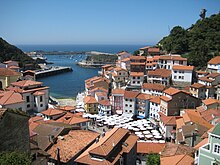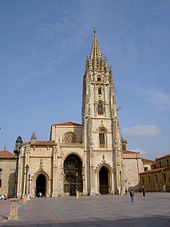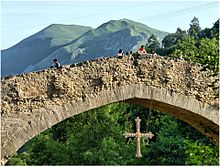Asturias, officially the Principality of Asturias (Spanish: Principado de Asturias, Asturian: Principáu d'Asturies), is a region in the north of Spain. It sits in the narrow strip between the Cantabrian Sea and the Cantabrian Mountains, forming part of "Green Spain". It has been given the nickname "little Switzerland" because of the greenness of its meadows and the height of its peaks.
Cities and towns
edit- 1 Oviedo is the capital of Asturias. It has a fine old town and cathedral.
- 2 Avilés near the airport is mostly industrial, but has several museums and old buildings.
- 3 Covadonga, the site of the first Christian victory against the Moors, in 722 AD. The Sanctuary of Covadonga is a complex of religious buildings commemorating this.
- 4 Gedrez is an attractive village, centre of the Fuentes del Narcea National Park.
- 5 Gijón (Xixón), the largest city of the principality, has beaches and a railway museum.
- 6 Grado, a town on the Original Way of St. James (Camino Primitivo).
- 7 Langreo is industrial, with a mining museum.
- 8 Villaviciosa is a cider-making town on the coast.
- 9 Llastres, a small fishing port, is one of the most attractive villages in the region.
- 10 Luanco is a fishing village with an interesting historic centre, beautiful beaches, and many palace buildings from the 18th century.
- 11 Ribadesella has a cave decorated with prehistoric art. In August it hosts the Descenso rowing race down the river.
Other destinations
edit
- 1 Picos de Europa National Park is an area of mountains and woodlands stretching into the neighbouring regions of Cantabria and Castile & León.
Understand
editHistory
editWhen the Moors began their invasion of Spain in the 8th century, the mountainous territory of Asturias was difficult to conquer, and this region became a refuge for Christian nobles. In 722, a de facto independent kingdom was established, which became the cradle of the incipient Reconquista (Reconquest).
In the 10th century, the Kingdom of Asturias gave way to the Kingdom of LeónThrough the rebellion of Prince Henry (the later Henry II of Castile) in the 14th century, the Principality of Asturias was established. Since 1388, the heir to the Castilian (later Spanish) throne has been styled "Prince of Asturias". Since June 2014, the title us held by Leonor, Princess of Asturias.
In the 18th century, Asturias was one of the centres of the Spanish Enlightenment. The Industrial Revolution came to Asturias after 1830 with the discovery and systematic exploitation of coal mines and iron factories at the mining basins of Nalón and Caudal. At the same time, there was significant migration to the Americas (especially Argentina, Uruguay, Puerto Rico, Cuba and Mexico); those who succeeded overseas often returned to their native land much wealthier. These entrepreneurs were known collectively as 'Indianos', for having visited and made their fortunes in the West Indies and beyond. The heritage of these wealthy families can still be seen in Asturias today: many large 'modernista' villas are dotted across the region, as well as cultural institutions such as free schools and public libraries.
Since 1981, Asturias has been an autonomous community within Spain.
Climate
edit
The region has a maritime climate. It receives plenty of annual rainfall and little sunshine by Spanish standards and has very moderated seasons, most often averaging in the lower 20s Celsius. Heat waves are rare due to mountains blocking southerly winds. Winters are very mild for the latitude, especially near sea level.
Talk
editAsturias has its own language, Asturian, although everyone speaks Spanish.
Asturian (also called Bable, but this is a derogatory term) is a Romance language spoken in some parts of the provinces of Asturias and León in Spain, and in the area of Miranda de Douro in Portugal (where it is co-official and officially called Mirandese). In Asturias, it is protected under the Autonomous Status legislation, and it is an optional language at schools. There was a diglossia conflict between Asturian and Spanish, which resulted in some scholars considering it a dialect. However, nowadays, it is considered a separate language.
Much effort has been made since 1980 to protect and promote Asturian among the Asturian population. However, establishing the language as a co-official tongue is still awaited in most areas to protect this minority Romance language better. The situation of Asturian in other parts of Spain is critical, with a large decline in the number of speakers in the last 100 years. The area of Miranda de Douro in Portugal has taken a further step in protecting this language, by making it co-official.
Though Asturian and Spanish are highly similar to one another, the prevalence of Asturian on road signs and maps means that travelers, for instance, may need to pay attention to name changes, such as how Oviedo becomes Uviéu and Gijón becomes Xixón.
One must also be aware while traveling through Asturias that almost nobody speaks English. In other parts of Spain one can come across people who speak English to a limited extent (particularly in the larger cities), yet rarely will Asturians be able to understand you unless you make a considerable effort brush up on your Spanish. Bring a phrasebook and translate as you go if need be; the Asturian people are remarkably patient and welcoming and will be glad to invest time in helping you understand their culture, which they are intensely proud of.
Get in
editBy plane: 1 Asturias airport (OVD IATA) is 10 km west of Avilés, with buses to that town and to Oviedo and Gijón. It has frequent flights from Madrid, also from Barcelona, Sevilla and Palma de Mallorca, but lacks international flights.
Consider using Santander airport, which has budget flights (eg Ryanair from London Stansted) and is 3 hours by bus from Oviedo. Otherwise fly to Madrid and take the bus or train onward.
By bus: ALSA buses from Madrid take 5 hours to Oviedo.
By train: Renfe trains run from Madrid via Segovia, Valladolid and Leon to Oviedo and Gijón.
Get around
editAll Asturian cities are very walkable, as they're quite compact. If you need a way to get around, bus and taxi are the two best options. Taxi stands are all over the city, and charge a base fee of around €4. Getting from one side of the city to the other costs about €8. Buses are the most convenient, and cheapest form of travel. The run from early in the morning until 23:00. Urban buses are around €0.85. Schedules are available at tourist offices and bus stops. To travel between cities, both train and bus are good. There are 2 train networks: Renfe (the national railways) and Feve (smaller trains). They sometimes share station but not always. Finding them won't be a problem, though, as they're always clearly shown on maps.
See
edit
Oviedo, the capital city of Asturias, is home to Santa María del Naranco and San Miguel de Lillo, a pre-Romanesque church and a palace respectively, which were built by the first Asturian kings on Mount Naranco, to the north of the city (World Heritage Site). In modern architecture, the Palacio de Congresos de Oviedo (or Modoo) was designed by Santiago Calatrava.
Gijon, the biggest city of Asturias, is a coastal city known for cultural and sports events, and a beach tourism centre in northern Spain. It also is known for the traditional Asturian gastronomy and for Asturian cider production. Museums in the city include the Universidad Laboral de Gijón, including a modern art museum and theatre.
Avilés is the third largest city in Asturias. "Saint Nicholas of Bari" or "Capilla de los Alas" in Romanesque and Romanesque-Gothic style, respectively; Palacio de Balsera, in Modernist style or St. Thomas of Canterbury church (dating from the 13th century) are examples which show the historical patrimony to be found in the city. The Centro Niemeyer, designed by the Brazilian architect Oscar Niemeyer, is an example of contemporary architecture in Asturias.
The Picos de Europa National Park, and other parts of the Asturian mountain range: the Picu Urriellu mountain (2519 m or 8262 ft), also known as El Naranjo de Bulnes, is a molar-shaped peak which, reputedly, glows orange in the evening sun, hence its name. Weather permitting, it can be viewed from Camarmeña village, near Poncebos, south of Arenas de Cabrales.


The shrine to the Virgin of Covadonga and the mountain lakes (Los Lagos), near Cangas de Onís. Legend has it that in the 8th century, the Virgin blessed Asturian Christian forces with a well-timed signal to attack Spain's Moorish conquerors, thereby taking the invaders by surprise in the Battle of Covadonga. The Reconquista and eventual unification of all Spain is therefore said to have started in this very location.
The paleolithic art in the caves of Asturias is declared World Heritage Site with the Paleolithic Art of Northern Spain.
Asturias also has examples of industrial heritage as a consequence of its industrial activities in the 19th and 20th centuries. It had metallurgical and chemical factories, mines, bridges and railways, including in the towns of Langreo, Mieres and Avilés.
The Asturian coast: especially the beaches in and around the summer resort of Llanes, the Playa del Silencio near Cudillero fishing village, or the "white" village of Luarca (Severo Ochoa hometown).
- Visit the UNESCO World Network of Biosphere Reserves in Asturias
- Muniellos
- Somiedo
- Redes
- Picos de Europa
- Las Ubiñas-La Mesa
- Ponga
Do
editLos Premios Principes de Asturias are awards given by the Prince of Spain, known as the prince of Asturias, to various people for various categories. Previous winners are Nelson Mandela, Al Gore, Bill Gates, and Oviedo's very own Formula One racer Fernando Alonso. These awards take place each fall, and are held in Oviedo.
Some of the most famous festivals in Asturias are from the small town of Llanes. These festivals celebrate the important saints and the Virgin Mary adored by the town. The associations that prepare the festivals have a rivalry between them and each year they try to outdo each other with more impressive shows. The three most important are the festival of San Roque (St. Roque) held on the 16th of August, the festival of Nuestra Señora Virgen de La Guia (Our Lady, Virgin Mary, the Guide) held on the 8th of September, and the festival of Santa Maria Magdalena (St. Mary Magdalene) held on the 22nd of July. The Magdalena is well known for its impressive march of logs where boys as young as 3 and men carry logs through the town until they reach the end point and start a large bonfire.
- 1 Senda del oso. 50k hiking railtrail. Very beautiful and has some bears to see too! free.
Eat
editFabada. Beans stew made of white beans of typical asturian type, red sausage (chorizo), black pudding (morcilla) and diced bacon.
Cheese. There are more than a hundred of different types of cheese in Asturias. The more well known is Cabrales cheese. Cabrales cheese is produced only in the village of the same name and three villages of the Peñamellera Alta township, located on the northern spur of the Europa Peaks in eastern Asturias. This is certainly the most well-known Spanish blue cheese due to the manner in which goat farmers jealously guard its origin and authenticity; and one of the great blue cheeses of the world. Also its highly recommended cheese Gamoneu, which is considered to be one of the best cheeses in Europe, its a special kind of blue cheese, similar to Cabrales, but smoother and more solid, quite expensive and hard to find.
Frixuelos: These are very similar to the French crêpes (actually have the same Celtic/atlantic arc-cuisine origin), and are eaten as a dessert.
Cachopo: Its a delicious breaded, fried kid of "sandwich" of ham and cheese, cachopo is a little similar to Cordon Bleu but a lot bigger. Make sure to eat it in a good place, as many places will use cheaper ingredients and you won't be getting the real thing.
Arroz con Leche: Its a rice pudding dessert, also very popular made just in Asturias, every place has its very own recipe.
In general it's recommended to eat in small villages or places far from the city center, the quality of the food will always better and of course more affordable prices. When you eat in some central location you will be paying the location more than the food.
Drink
editCider. Made of local apples, like the Raxao and Xuanina types. The peculiar way it is served is called "escanciar", dropping the cider from the bottle hold with one hand above the head while the thin wide special glass is hold with the other hand under the hip level.
Calimocho, made of red wine, Coke, and current or blackberry syrup is delicious, and fun when used to play Duro (see above).
Sleep
editStay safe
editCrime is definitely not a big problem in Asturias. In the inner cities, as night life is huge, and even grandmothers pushing strollers can be seen at midnight, being out late isn't a big concern (I felt safe walking 30 minutes home alone at night, and I'm female, although it is always preferable to walk with others at night as an added precaution). Of course it depends on the area and bags can be snatched every now and then, so use common sense.
Asturias is considered one of the safest places in Europe, and its capital (Oviedo) has been awarded as the safest city in Europe. Children or women can walk alone all the night long without their parents caring.
Any hikers attempting to traverse parts of Asturias on foot should also be wary of the region's notorious weather. Asturias is unlike the majority of Spain, in that consecutive days of non-stop rain and drizzle accompanied by summer temperatures barely reaching 20°C are not uncommon. However, the biggest problem any outdoor types will face is how fast the weather can change. One can be walking in clear blue skies and warm weather and suddenly find themselves stranded in exceedingly dense fog (and vice versa, meaning one must always carry a suitable amount of water and protection from the sun).
Go next
edit- Galicia - Rugged, mountainous and with an extensive coastline, this region to the west bears many similarities to Asturias whilst still maintaining its own traditions, such as its own language and a unique cuisine.

